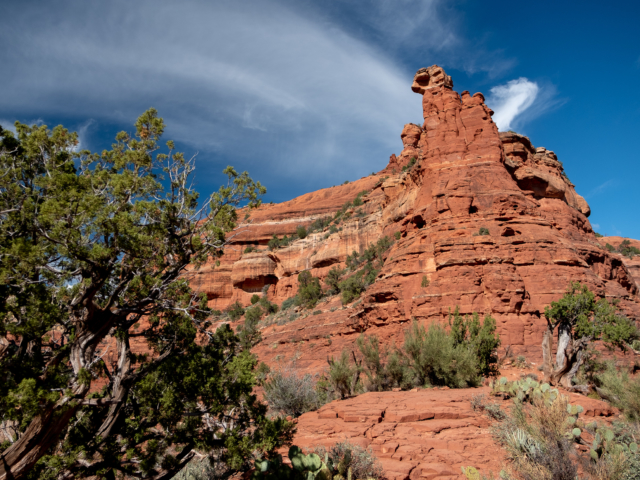Boynton Canyon is a box canyon located just north of the core business and residential districts of Sedona, Arizona. It is a popular attraction with visitors to the area for multiple reasons. It’s renowned for the diverse plant and wildlife that can be witnessed within its vicinity, as well as the outstanding views on display from its highest point. It’s also well-regarded by many people on account of the popularity of Boynton Canyon Trail, a three-mile hike that ascends some 500 feet to the top of the Canyon cliffside. Boynton Canyon has also developed a reputation in recent years for being a place of spiritual reflection. Regarded today as one of Sedona’s famous vortex sites, Boynton Canyon is a destination for many visitors who flock to it in search of balance, mindfulness, and inner peace.
Boynton Canyon History and Background
Like all of the many natural wonders on display throughout the greater Sedona area, Boynton Canyon is located within the boundaries of Coconino National Forest. This approximately 1.9-million-acre area is protected and maintained by the United States Forest Service. It is considered one of the most ecologically diverse national forests in the entire United States—and the case of Boynton Canyon is itself a superb example of this. Parts of Boynton Canyon (especially near its floor) are dry, dusty, and even desolate in places; other stretches, though, run thick with heavy forest growth. On the whole, it’s a special place rich in natural beauty and diversity.
What’s at Boynton Canyon
Boynton Canyon is considered a tremendous example of the sort of box canyon found all throughout the American Southwest, but particularly prevalent in the distinctive red-rock area that comprises the greater Sedona region. The scenery here is quite attractive—the eye will be caught continually by the site’s mixture of lofty buttes and red-rock formations. Also, many visitors to Boynton Canyon are drawn to the spot for the area’s reported power as a vortex site; Boynton Canyon’s reputation as a place of great spirituality and peacefulness has only increased its popularity and appeal in recent years.
Regardless of whether or not you’re interested in its vortex power, Boynton Canyon is perhaps best known for being the location of the trailhead for Boynton Canyon Trail. This trailhead is situated at the end of a paved road, which is convenient for visitors traveling in all sorts of different vehicles. The hike is some six miles roundtrip, and difficult going in places—but those who undertake it routinely say it is well-worth the effort. Two smaller hiking routes—Dead Man’s Pass and Vista Trail—are also found nearby.
Boynton Canyon is located only about 5 miles off Arizona State Route 89A, better known in certain stretches as the delightful Oak Creek Canyon Scenic Drive. Because of this prominent location, Boynton Canyon is very accessible. Not too far away you’ll encounter the majority of the Sedona area’s most popular attractions—including such famous sites as Doe Mountain, Palatki and Honanki Ruins, Red Rock State Park, and the Red Rock Scenic Byway, just to name a few—as well as all manner of dining and lodging options.
Tips for Visiting Boynton Canyon
- Boynton Canyon and Boynton Canyon Trail may be explored year-round. However, if you are hiking through this area during the summer months, protective clothing, sunscreen, and plentiful water are a must, as conditions can be quite rough at times here during the summer season. Significant portions of Boynton Canyon Trail do not provide any shelter or shade.
- There are restrooms available near the trailhead for Boynton Canyon Trail.
- If you’re looking for a more structured outing to Boynton Canyon, multiple tour companies provide guided tours/hikes throughout this area—so keep that in mind as you plan your visit.
- There is a parking lot situated near the trailhead of Boynton Canyon Trail. Like all such parking lots you’ll find in the Sedona area, you’ll need to purchase a pass to use the facilities here. The most common pass is a $5 day pass that may be purchased at a vending machine nearby. Many of these machines only accept credit cards.

